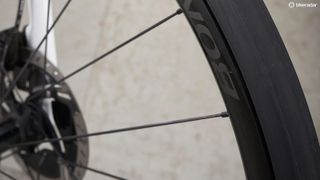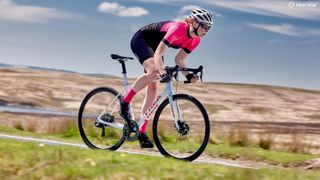You can trust Cyclingnews





This article first appeared on BikeRadar.
BikeRadar Score: 4 stars
BikeRadar Verdict: "Wonderful in every respect and the price ensures exclusivity"
- Highs: Beautifully balanced handling, low, low weight; a technical marvel
- Lows: It’s hard to wrap your head around a 10-grand-plus price tag
- Buy if: You want the lightest disc chassis around and you’ve got deep pockets or a lottery win
With the original Émonda, Trek set out to upset the applecart by making a full-production bike that could beat the most exclusive niche brands at their own lightweight game — the resulting frame weighing 690g.
The original was a fine lightweight bike, but its ride was harder than the plush Domane and Trek’s IsoSpeed-equipped aero Madone.
This new generation bike sees improved compliance in the frame and it’s lighter still at just 665g for this disc brake version. When you add in a new disc fork at 350g, the SLR9 Disc is one svelte chassis.
Every size and every configuration of the SLR will be available in both H1 and H2 fit for both disc and rim brake frames. If you favour a longer, lower position go for the H1, while if you’re looking for a more endurance-focussed ride you can opt for the H2 model, which is what I went for in this Project 1 build.
It is constructed from Trek’s 700 series premium-grade OCLV carbon — but this isn’t the same 700 series as before. Trek has altered the grade of the carbon and fibres, changed the lamination and refined production methods.

I opted for Bontrager Aeolus XXX2 wheels
To get this Project 1 bike as close to that which Trek-Segafredo used at the Tour I chose the latest Bontrager Aeolus XXX2 wheels, but in a more practical tubeless-compatible clincher rather than tubular, and these flyweights really add something to the Trek’s excellent ride quality.
At just 1,380g a pair (630g front and 750g rear) these are seriously light, and it’s a lightness you can feel on the climbs. They are also a very welcome 21mm wide internally, which allows you to exploit the lower rolling resistance and extra comfort and cushioning afforded by the 28mm Bontrager tyres, although I would have liked the bike to come set up tubeless.
The instant pick-up from the Émonda is addictive, and I quickly found myself getting out of the saddle and attacking any slope or gradient, such is the wonderfully responsive ride the SLR provides.
Thankfully it’s no slouch when the road heads down either, with the unmoving quality of the front end allowing for proper point-and-shoot descending where you can rely on the brakes and the large diameter 160mm noise-free rotors.

Ride quality is brilliant, it’s light and agile
To be honest, there is very little to fault on the SLR — the ride quality is brilliant, it’s as light as you’d ever need and it’s as agile as a gymnast. It never failed to put a smile on my face or make me want to be a better rider — it’s very much a bike you want to live up to and not the sort I’d feel comfortable taking out for a lazy Sunday cruise.
The only issue I do have is the price. At £10,160 it’s breathtakingly expensive, even taking into account the fact that this follows three years of carbon fibre development from Trek’s technical team and the excellent Project 1 customer service, which offers you advice, fitting and custom options. It is still £910 more than the similarly sublime S-Works Tarmac, and that has a power meter thrown in.
The SLR9 is very much like the 2018 BMC Team Machine SLR01 Disc. It is without a doubt a five-star performing bike, but it’s tough to give full marks to a bike that’s just so very expensive.